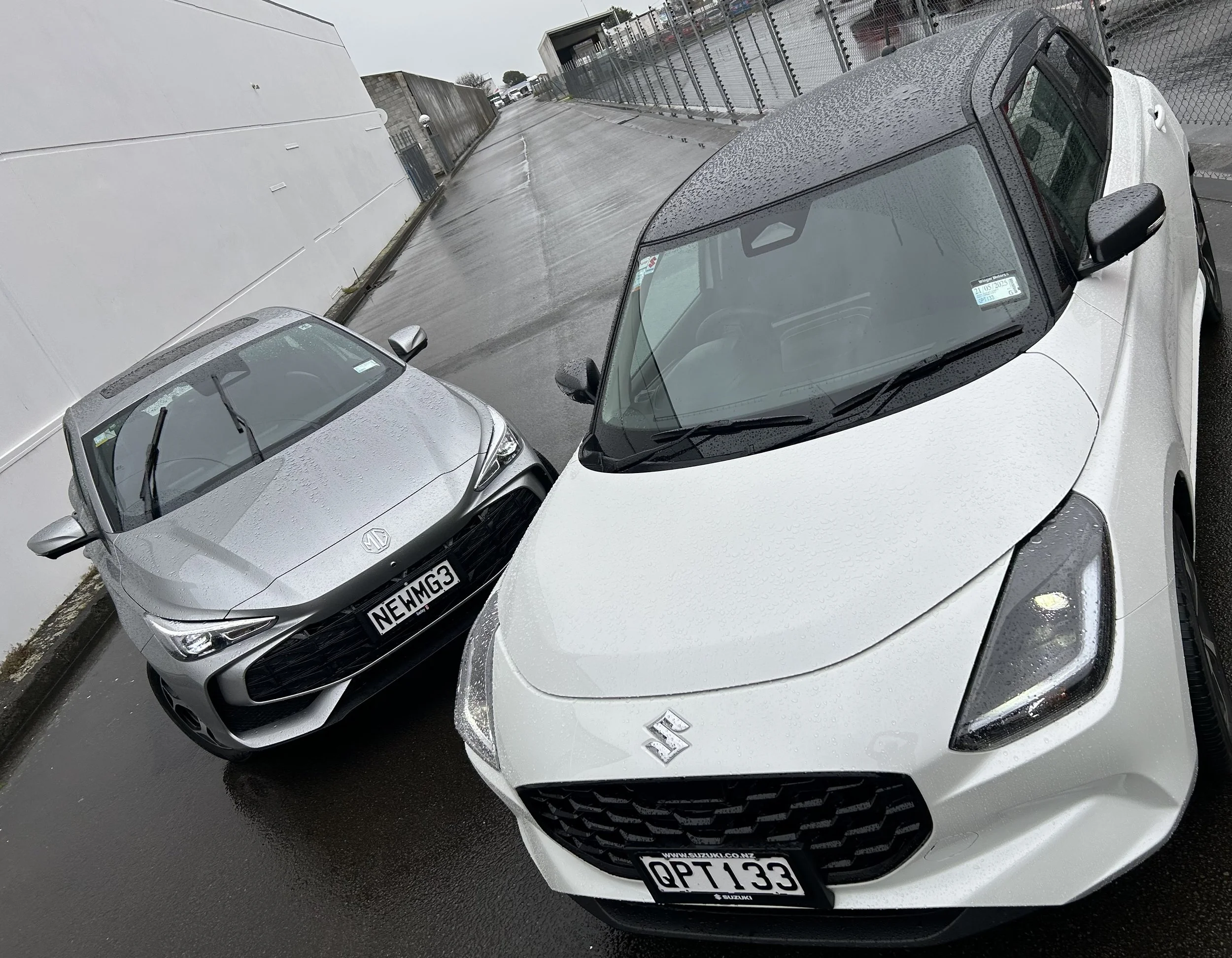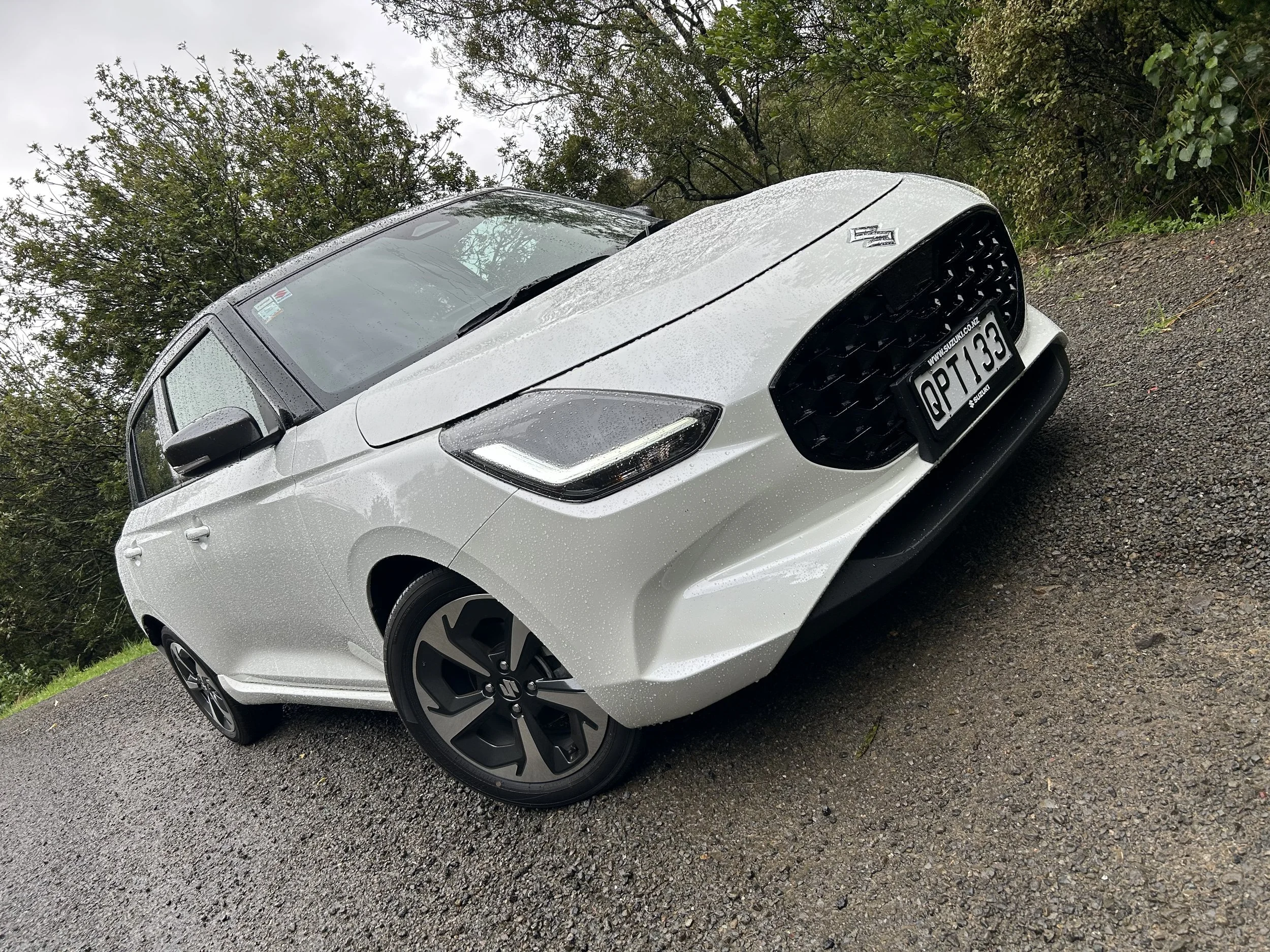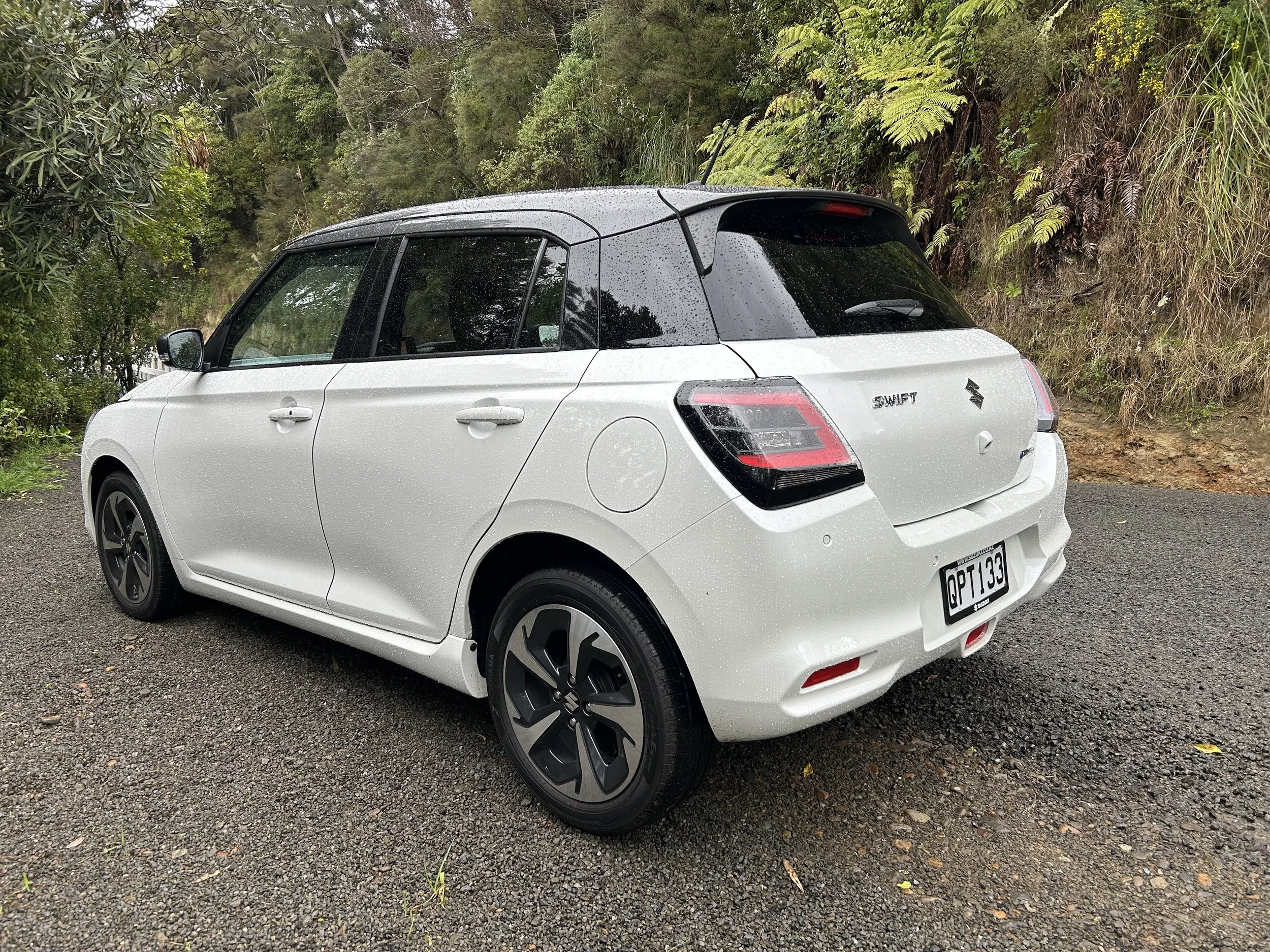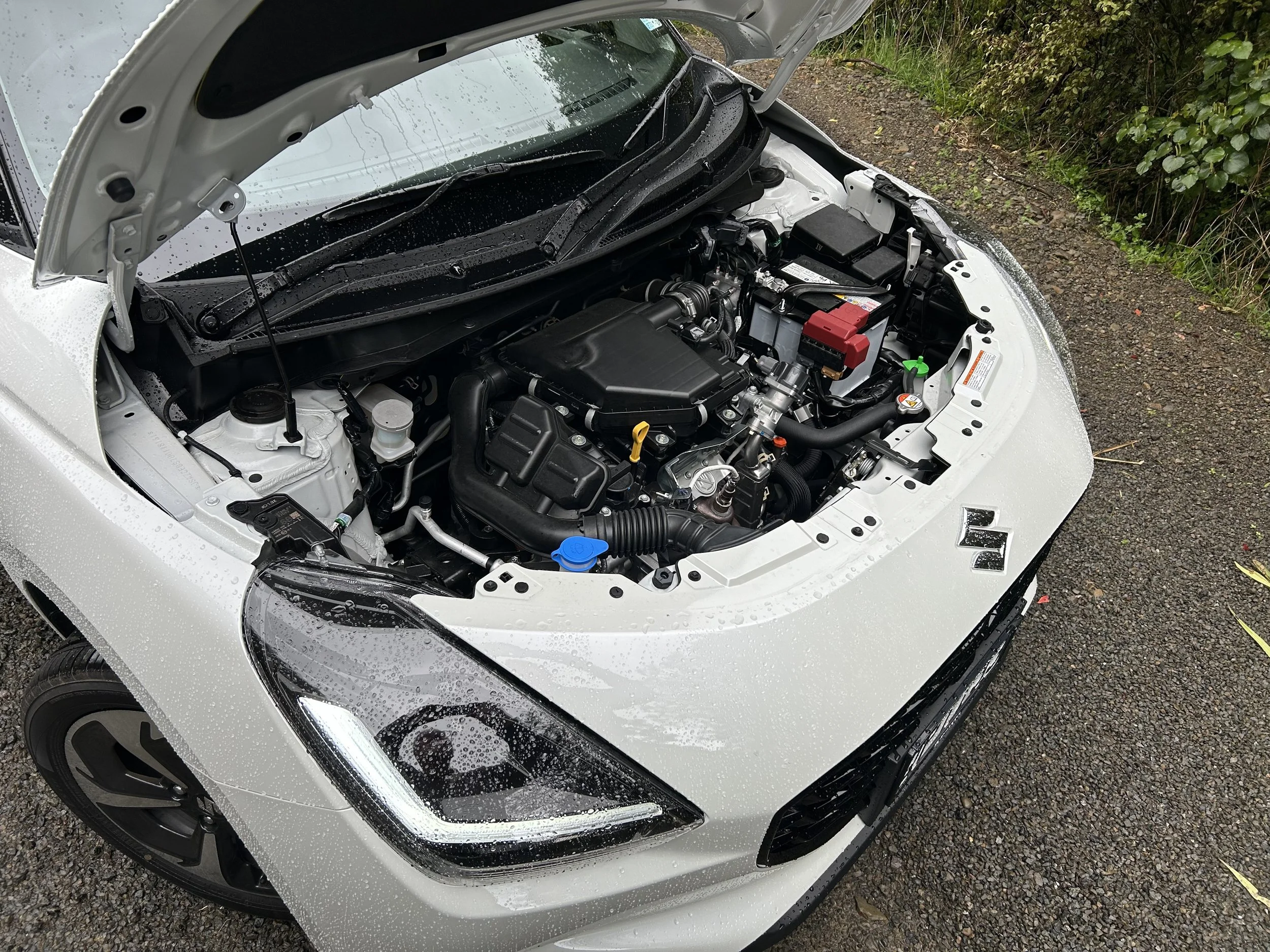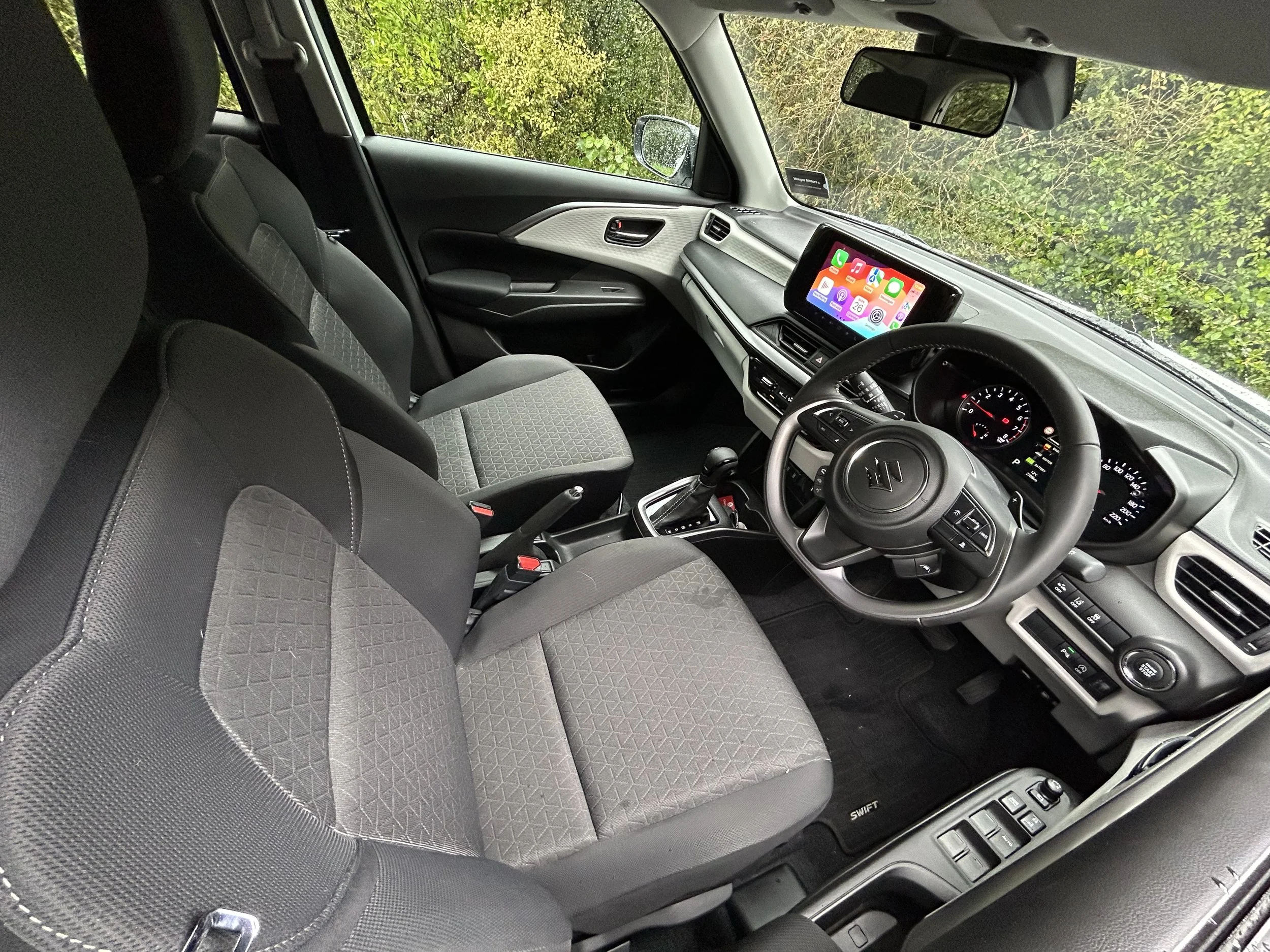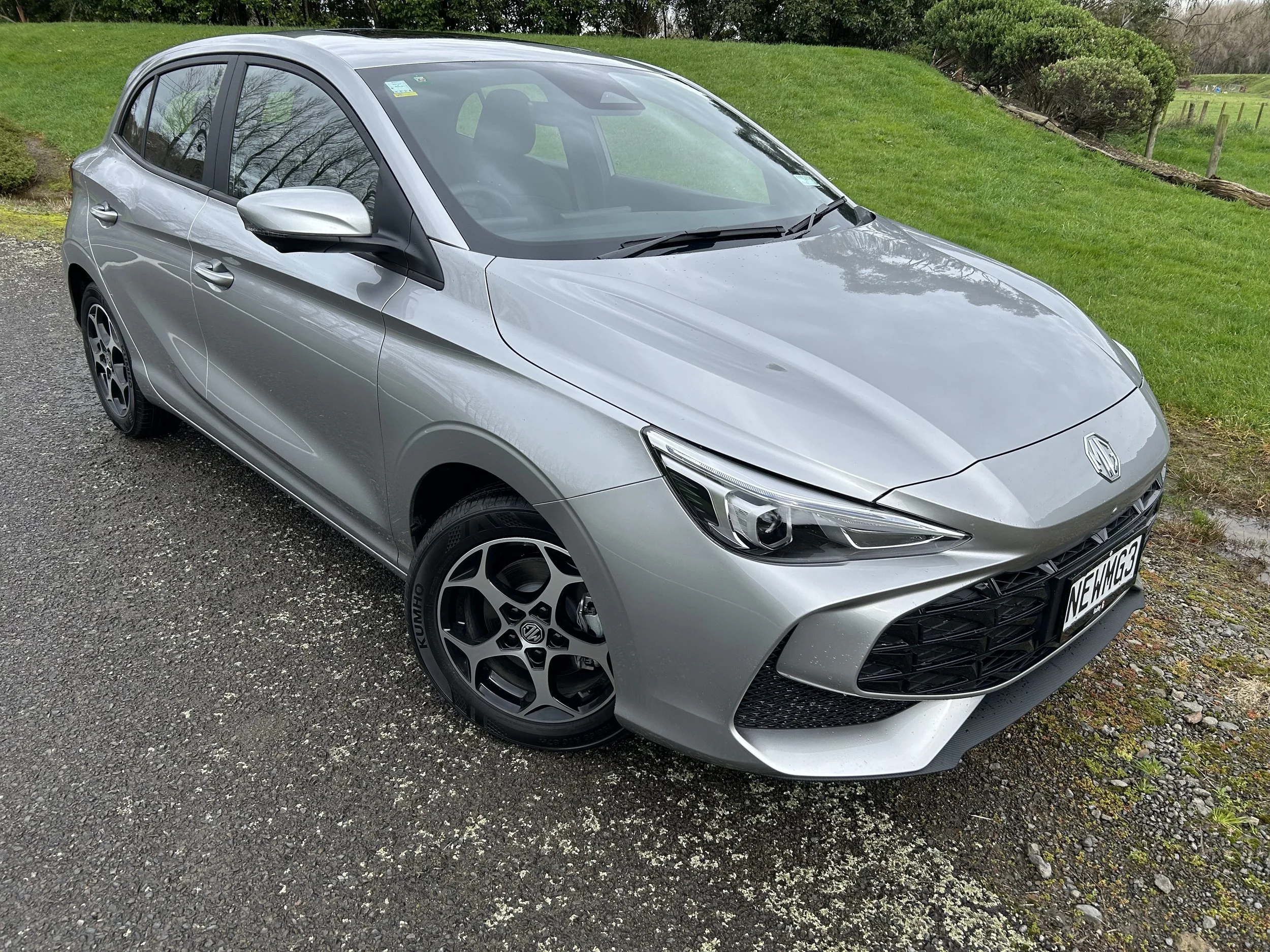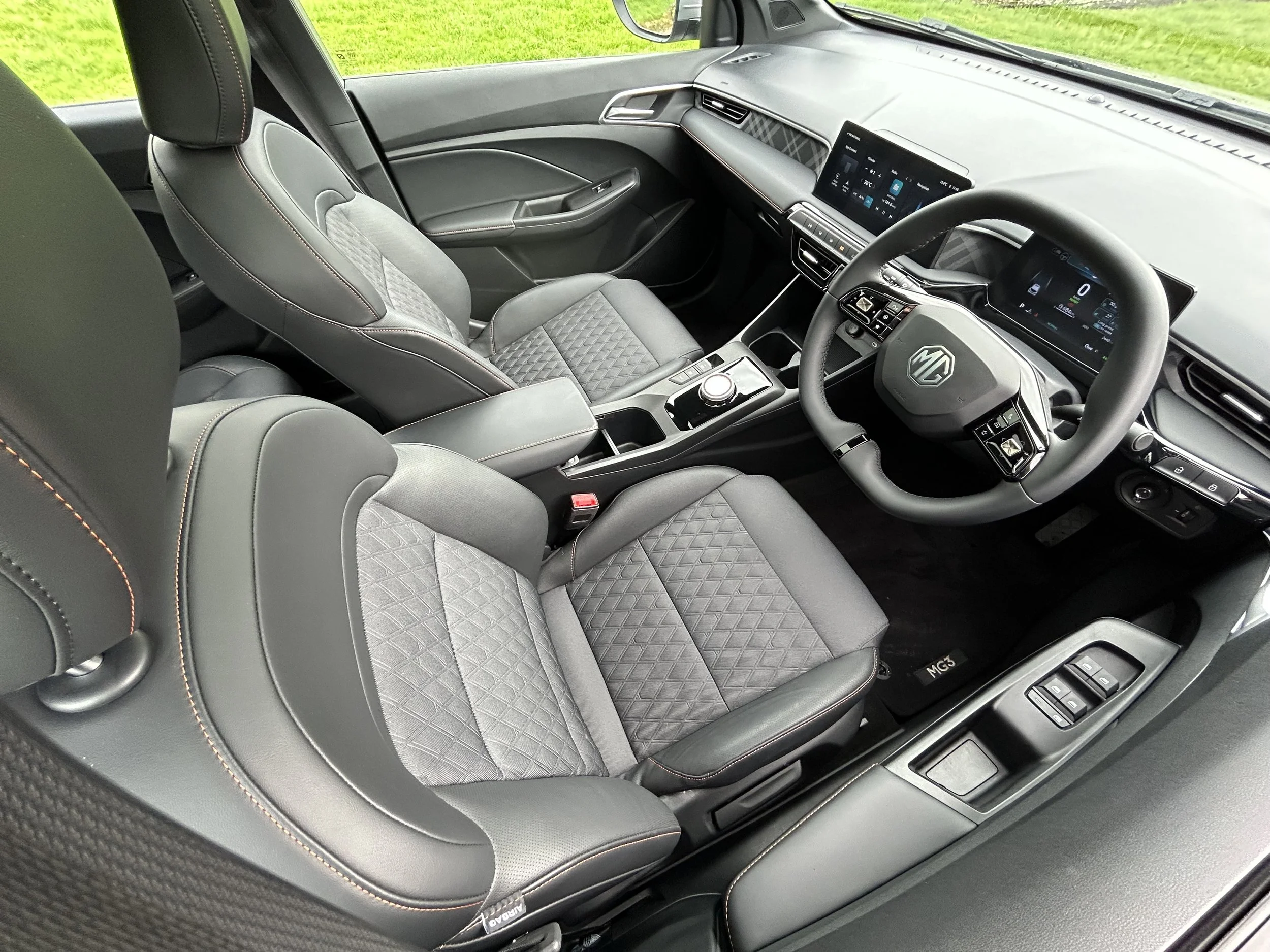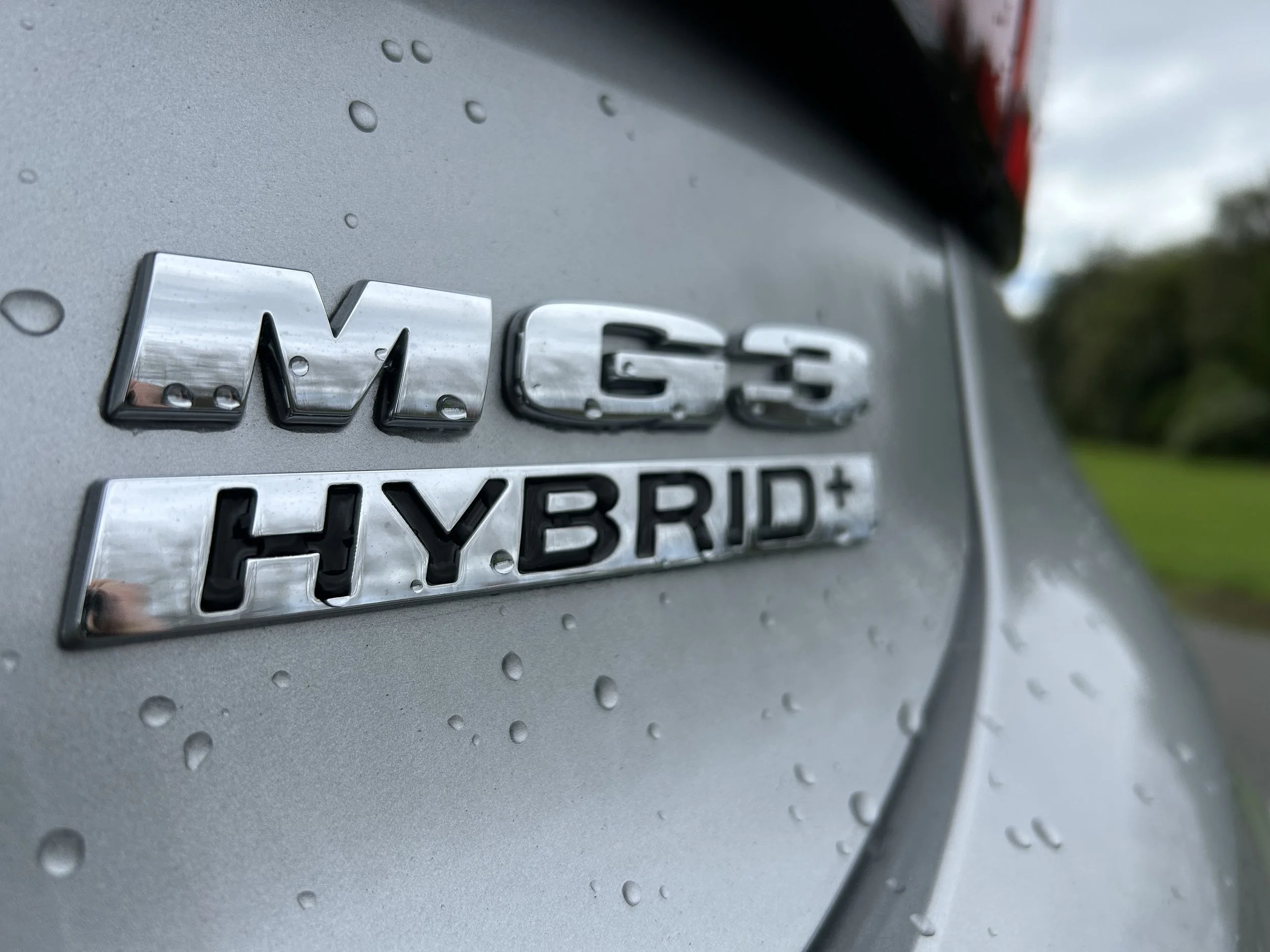Suzuki Swift RSC/MG MG3 Hybrid Plus roadtest review: Sippy nipper showdown
/Electric assist is becoming a thing for small cars, so how good are the latest mainstream competitors?
Suzuki Swift RSC
Price: $29,990
Powertrain: Three-cylinder petrol with mild 48v integrated starter generator hybrid, maximum power 61kW @ 5700rpm, maximum torque 112Nm @ 4500rpm, constantly variable transmission.
We like: Not the most advance, but holds is own; good driving feel; well built; as practical as ever.
Not so much: CVT reduces car’s snappiness; a 48v assist barely rates as a hybrid these days; some cost-cutting too evident.
MG MG3 Hybrid Plus Essence
Price: $31,990
Powertrain: Four-cylinder petrol with electric motor assist, engine power 75kW @ 6000rpm, engine torque 128Nm @ 4500rpm, motor output 100kW/250Nm; three-speed transmission.
We like: A big improvement over predecessor; sensible ride quality; strong content provision.
Not so much: Uninspiring interior; fancy hybrid doesn’t match Japan’s best.
GOING fully electric with a small car isn’t an impossibility - Fiat, with the 500e, and Mini with the previous and incoming new Cooper deliver this potential - but what tempers Suzuki and MG ambition is need to stick to their A game.
As in ‘A’ for ‘affordable.’ Premium Euro brands have well-heeled customers; the folk Suzuki and MG generally sell to are arguably more pragmatic. Prudence also affects brand plans. The margins on mainstream small cars have made it difficult for manufacturers to make money on them. Adding in the extra cost of electrification elevates the caution about what to deliver and when.
That’s not to say either is sitting back. The latest Swift and the MG3 are both are now in hybrid. The Chinese make’s is particularly advanced. Both kinds carry a premium over pure petrol alternates.
So, having spent quality time with each, where is the money better spent?
Swift RSC
EFFICIENT, energetic and effervescent engines are a Suzuki thing - the Swift’s latest relates that promise, while also sharpening eco credential.
All the same, it’s the mildest of mild hybrids. Of the same 1197cc capacity as one Suzuki placed as an option in the previous range and with a similar technical approach, in favouring a 48 volt integrated starter generator type, but wholly different, being a three-cylinder now, having run as a four-pot previously.
Outputs are essentially equal, with 60.9kW at 5700rpm and maximum torque of 111.8Nm at 4500rpm. Gain comes with economy and lower emissions are down; 97 grams per kilometre isn’t quite Prius level, but is still pretty clean.
Drawbacks? The engine demands 95 octane fuel, which is pricier than the 91 octane most fuel misers prefer. Also, it’s a slightly less swift version of this famous Suzuki. While the ISG helps initially step off, the powertrain is bit less nippy now, with 0-100kmh in 10.8 seconds it’s not as quick as the 1.0-litre turbo Boosterjet now exiting the scene.
Suzuki reckons the ISG can also add a 2.3kW/60Nm boost to the new engine for up to 30 seconds, under certain operating conditions, including being below 3900rpm. They say. Frankly, it never feels overly plucky. on top of that, it’s not as aurally interesting as the old engine.
On the other hand, it is the right kind of powertrain for the times. The new ISG is teensy with a 2.3kW/60Nm DC motor feeding off a 12 volt lithium ion battery, but the helping hand it delivers is tangible beyond being very efficient with the stop-start side of things.
The system uses energy regenerated when braking - also to help power the vehicle as well as improve efficiency - and that recaptured energy is then used to run some of the electric system, so reducing load on the engine.
In leaving $10 from a $30k spend the RSC here is the top buy but cheaper than the old hybrid, which is a positive. It is still a relatively cheap car to buy into.
You can see why the national distributor is confident a traditional buyer base whose support has put 33,000 Swifts into circulation since 2005, when the car settled into the signature styling theme this one continues with, will find much to like.
What helps the Swift carry pace is the lightweight Heartect platform, basically transferred with little revision save additional stiffening, so unsurprisingly the latest has inherited that predecessor’s dynamic verve, though only to a point. The next Sport will quite rightly be the full fun one.
The RSC handles neatly, with good body control when chucked through corners, but you need to be reasonable. The top type running on bigger tyres than the cheaper GLS helps with grip, but maybe degrades for road noise. But given that Swift is more city than country in general application, that’s not really a big worry.
The same thought needs apply to the kind of transmission it now drills down into. Historically, the most ‘fun’ Swifts have had manual gearboxes. And the least are CVTs, as now? Well, that’s might be an oversimplification, but Suzuki is famous for making zingy engines and you could really make them sing with a three-pedal set up. Even though in RSC you have a manual mode and paddle shifts, with the CVT it is harder to hit those sweet spots when you’re pushing along. That’s another element that enforces that Swift works best in urban environs.
Looks-wise, the 2024 car is clearly a bit bigger and with a chunkier visual ambience, but overall it’s the fourth Swift in a row that is more evolution than revolution.
The car is slightly longer and lower than the outgoing type, with the same wheelbase and brings into the roadscape near identical styling to a concept Suzuki revealed in 2022.
Suzuki claims the mild styling changes have improved aerodynamic performance by 4.6 percent with discrete spoilers, a reshaped bumper, new alloy wheels. A return to rear door handles might cause more wind bustle, but it’s worth that issue. These will be welcomed by those confused by the predecessor’s ‘hidden’ types.
Inside, the new cars picks up a fresh, enlarged to nine inches’ touchscreen with enhanced connectivity, including the same wireless Apple CarPlay/Android Auto first seen on last year’s S-Cross update.
The GLS comes standard with parking sensors, built-in navigation, keyless entry with push-button start, and traffic sign recognition amongst its safety features, but it surely rules itself out of a lot of private consideration by having steel rims and plastic wheel trims and no driver’s lacking height adjust.
The RSC just looks a better buy. It has additional charge ports, climate air with fancier controls, a leather-bound wheel, heated seats with adjustment, privacy glass, blind spot monitoring and rear cross traffic alert, and 16-inch alloys.
Swift cried out for an interior refit, and it’s a pity Suzuki didn’t work harder. The new touchscreen is a friendlier device and more useful in being slightly angled towards the driver, but as is typical of product from this brand the choice of materials tends toward the uninspiring, and at times outright cheap in feel, though there’s very little wrong with the apparent solidity with which the cabin is assembled. But cost-cutting and reluctance to move into new elements when the old work fine are evident; these days analogue dials, while coherent, seem a bit old-fashioned. The panel seems awfully busy, too, with loads of icons, mainly for for driver assist functions.
The cabin seems fairly roomy, with enough space for four quite tall adults, but the boot space is not brilliant, with just 265 litres on offer when all five seats are upright. That's much the same as with the old Swift, but behind others in this price range. Take note, also, that this is the first Swift without a spare wheel. While there is split folding, the seats don’t fold flat.
In many ways, this fourth generation is just as it was expected to be; carrying on where the old car left off, but feeling a bit more modern than before, maintaining a decent value for money proposition, and set to be cheaper to drive, but also with more of a cost-conscious vibe than was previously evident.
The one big question mark is what kind of crash test score it will achieve from our national auditor. If the Australasian New Car Assessment Programme (ANCAP) choses to adopt a just issued judgement from its sister European NCAP, then it’ll take just three stars out of five - a middling score. One ANCAP requirement for an optimal result is driver monitoring. Swift doesn’t have that.
MG 3
CONCEIVABLY, this car has the goods to kick butt. MG is a fast-mover brand and, on paper, the hybridised edition is a technical tour de force.
In reality? There’s no doubt the second-gen MG3 is a big step up from the first; that advanced powertrain packs into a new generation that is a very different car to the old type. For all that, in But in respect to where it stands in the overall category, impression from this involvement was that it doesn’t quite smash the ball as hard as you’d hope it might.
A real pity, because the concept of offering, at a pretty decent price, car in this class that can power itself for short distances on the electric motor alone, but doesn’t need plugging in to charge, is a great idea.
What it needs to do, all the same, is prove itself to be as good as, if not better than, the established competition.
That’s where it gets a bit sticky … for all that it is better, it also imparts as being a bit unpolished.
Anyone with an eye for keeping running costs in check will surely consider the hybrid. MG reckons on 0.9L per 100km when the electric is fully involved, which is astoundingly good, but they also state 4.3L/100km as a combined figure while Rightcar reckons on 4.8L/100km. All those outcomes are assuredly a big step up on the new pure petrol engine’s 6.0L/100km (and the old’s 6.7L/km). But what about real life?
The Swift and MG 3 Hybrid were only together for a day, just long to be photographed, but not tested side by side. To compensate, the MG - which came second - was driven on the same roads, at the same speeds, for the same distance in as best as possible the same conditions (it rained more) as the Suzuki. Not exactly scientific, but surely good enough to be a barometer.
If you were betting, you say the MG had to do better. For one, in urban driving power comes mostly from its electric motor and it behaves more like an EV than most hybrids. Treat the throttle to a light touch and on flat roads you can get up to, and hold, it in electric drive, drawing purely from the 1.83kWh lithium-ion battery. I drove it to that regime as best I could.
Surely, it had to be better than the Swift and certainly it couldn’t have been any worse, right? Here’s the thing. They tied: 4.7L/100km.
On a positive side, this suggests you can drive the MG (and Swift) in totally ordinary manner and achieve an economy that is perfectly decent.
Does this exercise also remind that, on cars of this size, electrification can be a law of diminishing returns? Has MG’s focus on making this model more powerful than its hybrid rivals led to compromised fuel economy?
When it can do no better than match the real-world (and Suzuki-cited) fuel efficiency of a lightly hybridised type that’s slightly cleaner (sure, there’s just 3g/km in it) and $2000 cheaper to buy, is there enough advantage?
Take note, too, that like the Swift - and unlike the base, pure petrol MG3 (which has a same capacity, but very different engine) - the MG also shuns 91 octane petrol for 95 and, with a 36 litre tank (so, 1L shy of the Suzuki) will basically cost as much to refill from empty.
This doesn’t make it a lost cause by any means. As said, buy a new MG3 and you will be impressed how much improved it is over the old one. The design has really stepped up. You get a bigger car, with more features, including in the safety roster, yes. But also one that runs rings around the original for driving feel and performance. Which is great.
The look is contemporary five-door hatchback, but more cohesive. Styling was the work of MG’s Shanghai studio and it picks up obvious influence from the brand’s current crop of crossovers and hatchbacks.
At 4.1 metres in total length, it doesn’t threaten to stretch small car boundaries, but six centimetres are added to its length, with five of those coming in the wheelbase, and the body has widened by nearly 7cm, this complemented by a 4cm widening of the rear track. Height has reduced, by a mere 2mm. In respect to the Swift, it’s 25.3cm longer and 62mm wider (though 18mm lower) and has an extra 120mm in the wheelbase.
The wheelbase stretch frees up leg room in both rows of seats, but the design of the MG’s front seats impedes rear foot room more in the back than it does for the Swift.
In any event, the more significant plus from the MG3’s longer overall footprint is the increase in boot capacity at 298 litres. The Swift offers 265 litres, expanding to 980 litres with the rear seats folded, which is three litres short of the MG. Small differences, yes, but enough for MG to claim their car has one of the largest boots in the supermini segment. In both the seat back doesn’t fold fully flat, but in the MG it’s not split, which will limit versatility.
In respect to overall spacial consideration, the Swift still wins. The cabin feels airier and, also, it better suits a tall driver. The MG Essence has a sunroof which really compromises headroom.
MG has more comfort features than the Suzuki. Standard kit for an MG3 starts with Apple CarPlay and Android Auto connectivity and six speaker audio, heated exterior mirrors, button start, multi-function wheel, keyless entry, six speaker audio, multiple USB A and C plugs front and rear, single air conditioning, reverse camera, three top tethers, electric park brake and six air bags. The Essence adds LED headlights, Poly Urethane (PU) faux leather, rain sensing wipers, native sat nav and a 360-degree camera. It also ushers in a new feature called the MG iSmart app that through a smartphone, enables doors to be lock or unlocked and to switch on the air conditioning or heater. Annoyingly, there’s no smartphone Qi charger.
The cabin’s instrument layout strikes as an all-out departure from its predecessor, ushering in new ‘floating’ twin screens – a 7.0in digital instrument display and a 10.25in infotainment touchscreen – that feature new-look graphics and responsive activations; in look and operability, they make the Suzuki’s layout feel a bit old hat. On the other hand, MG has almost been too clever. Having removed physical climate controls in favour of virtual controls through the touchscreen makes them harder to adjust on the move. Those sorts of things make Swift’s simplicity seem smarter.
Conversely, though, cabin finish is where the MG still strikes as something of a budget buy. With exception of the steering wheel and armrests, almost all surfaces are hard, hollow-sounding plastic. The sliding tray beneath the front centre armrest looks set to break.
The steering wheel having several control buttons to access certain functions is supposed to make life easier but you wonder if that’s the case. The primary, right-side controller is finicky.
A hexagonal steering wheel is a nod to brand history, but honestly a round rim would be smarter. With this one, it’s hard to catch through your hands when cornering. The steering wheel is also large and can also only be raised or lowered. Even at its highest setting there wasn’t a lot of knee room for this lanky tester. The lack of telescopic reach adjustment and overly-soft seat cushions are matters asking for attention come the car’s mid-life refresh.
MG’s historic status as a sporting brand reveals through the powertrain’s pep - more in a bit - but less so in the dynamic set-up; handling-wise, it’s softer and less alert than the Swift. Conversely it has a more grown-up feel to its ride that will likely make it the more comfortable car for the primary buyer set. Bump suppression was clearly in the minds of the MG engineers in England who led suspension tuning. Though they look a bit small for the car, the 16-inch alloys do a great job of smoothing out surface imperfections. While the Suzuki is the more playful car, the MG3 smacks as being the one in which the overall driving feel is nicer.
The powertrain’s promise is an intrigue. The 75kW petrol and 100kW electric motor work together to achieve an impressive 155kW. That’s a substantial figure, up there in hot-hatch territory. MG here doesn’t officially quote a torque output, but other places cite 424Nm, also a lot for such a small car.
Fair to say the engine produces an impressive amount of poke off the line. Also, it offers more oomph than the Swift without feeling as strained; the coarseness that comes from the Japanese engine when it is accelerated hard is all but avoided here, which has a bearing on refinement.
A three-speed transmission is very much a curiosity; CVTs are more common with hybrids. MG reckons their way is superior because the electric motor is there to do most of the work most of the time.
However, brand claim that the tie-up avoids lag to give the car more responsive acceleration is a bit sketchy. With the test car, it didn’t. Put your foot down - as you might when having to leave a busy intersection - and there was a noticeable delay between the petrol engine springing into life to deliver the full power figure. It’s just not the way to a happy life. It’s a means to an end, but you wonder if MG will now be looking to refining this side of things.
Mind you it is a complex set-up. Basically, the electric motor is backed by a separate generator motor producing electric power alone. The system charges its largest-in-class 1.83kW battery as the vehicle is being driven and by harvesting power from regeneration.
The battery gives enough juice to cover short distances at speeds of up to 80kmh with the engine off; just like the Yaris, but for faster and longer, MG suggests.
It can be driven in Series mode – with the engine functioning as a generator – or as a parallel hybrid, where the two power sources work in tandem to give the full power output.
The powertrain’s operability and outcomes depend on which mode is driven in. There are eight - yes, eight - hybrid operational phases. From first exposure, it’s prudent to keep an eye on the various displays for economy and electric involvement. No surprise Sport is the least best enabler for optimal frugality. For city speed running, it’s fine in Eco and, on the motorway, holds its own in Normal.
The previous MG3 had fallen behind expectation for safety ingredients and driver assists. The new aimed to remedy that by adding forward collision and lane departure, monitoring of blind spots, rear cross traffic, tyre pressures and “unsteady driver”, and assistance features, spanning adaptive cruise, speed-limit notification, emergency lane keeping. That’s a lot of additional kit, but questions raised in ANCAP’s independent crash testing about how it ultimately operates and the integrity of some of the car’s design means it has to carry the same middling three-star crash test rating as the old one. Yes, the test is harder now, but technology has also ramped up. A stronger score would make it an easier sell.
Verdict.
It’s a tough one.
There are very good reasons why Swift has long been the country’s top-selling new small car and, by and large, the latest edition builds on the strengths of well-received predecessors. But switching to a CVT dilutes it character, the design is not as strong and, as much as a 48 volt system does enough now, will seem good enough in the long term?
MG knew it had to improve its smallest car. The previous first-gen format was utterly outdated and cheap for reasons beyond inexpensiveness.
This one is a huge step forward, not without a price uplift as well, but the technology involvement explains why the additional dollars are demanded.
As imperfect as it is, the MG 3 still stirs the pot more vigorously. At same token, you get sense a touch longer on the stovetop would have produced a more palatable dish.

